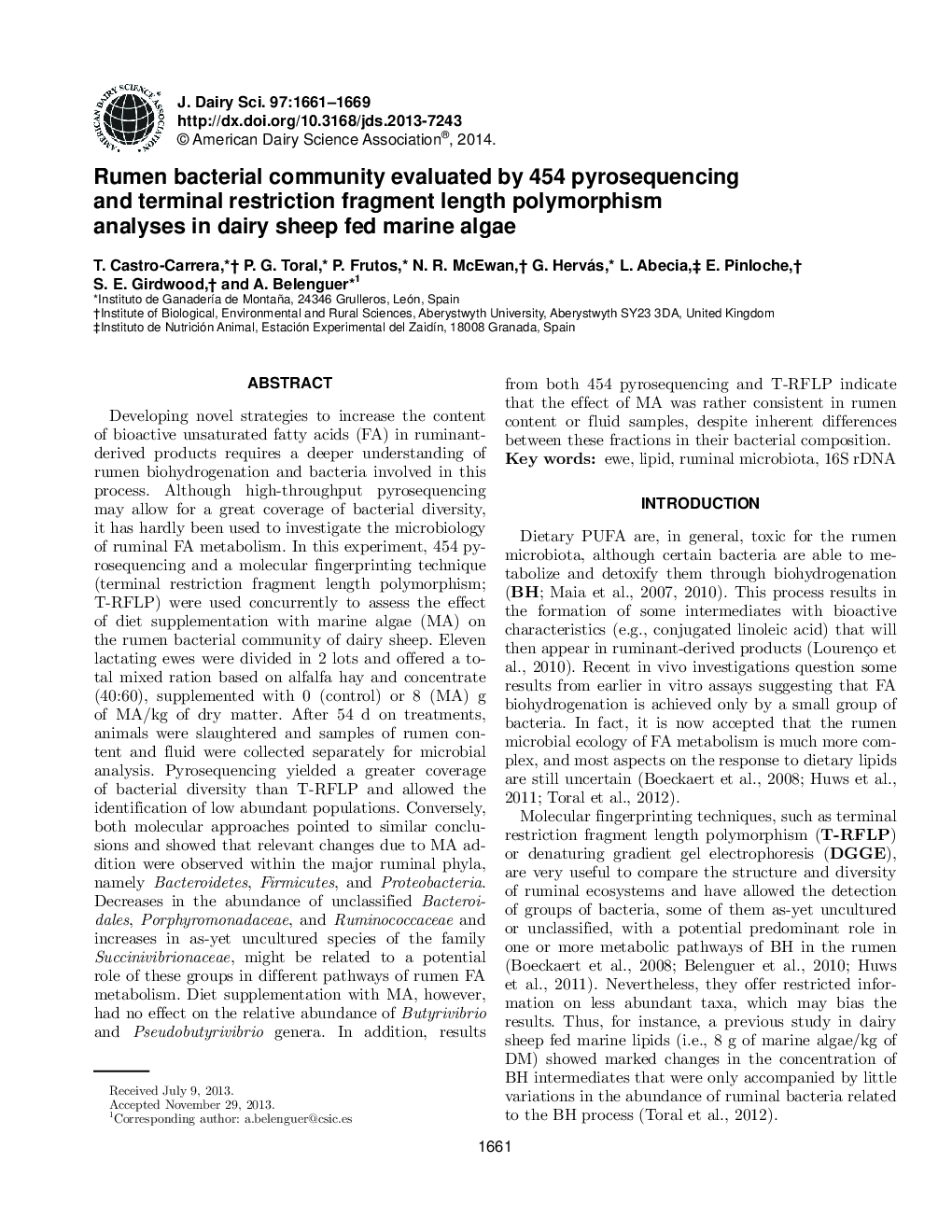| کد مقاله | کد نشریه | سال انتشار | مقاله انگلیسی | نسخه تمام متن |
|---|---|---|---|---|
| 10975173 | 1108031 | 2014 | 9 صفحه PDF | دانلود رایگان |
عنوان انگلیسی مقاله ISI
Rumen bacterial community evaluated by 454 pyrosequencing and terminal restriction fragment length polymorphism analyses in dairy sheep fed marine algae
دانلود مقاله + سفارش ترجمه
دانلود مقاله ISI انگلیسی
رایگان برای ایرانیان
موضوعات مرتبط
علوم زیستی و بیوفناوری
علوم کشاورزی و بیولوژیک
علوم دامی و جانورشناسی
پیش نمایش صفحه اول مقاله

چکیده انگلیسی
Developing novel strategies to increase the content of bioactive unsaturated fatty acids (FA) in ruminant-derived products requires a deeper understanding of rumen biohydrogenation and bacteria involved in this process. Although high-throughput pyrosequencing may allow for a great coverage of bacterial diversity, it has hardly been used to investigate the microbiology of ruminal FA metabolism. In this experiment, 454 pyrosequencing and a molecular fingerprinting technique (terminal restriction fragment length polymorphism; T-RFLP) were used concurrently to assess the effect of diet supplementation with marine algae (MA) on the rumen bacterial community of dairy sheep. Eleven lactating ewes were divided in 2 lots and offered a total mixed ration based on alfalfa hay and concentrate (40:60), supplemented with 0 (control) or 8 (MA) g of MA/kg of dry matter. After 54Â d on treatments, animals were slaughtered and samples of rumen content and fluid were collected separately for microbial analysis. Pyrosequencing yielded a greater coverage of bacterial diversity than T-RFLP and allowed the identification of low abundant populations. Conversely, both molecular approaches pointed to similar conclusions and showed that relevant changes due to MA addition were observed within the major ruminal phyla, namely Bacteroidetes, Firmicutes, and Proteobacteria. Decreases in the abundance of unclassified Bacteroidales, Porphyromonadaceae, and Ruminococcaceae and increases in as-yet uncultured species of the family Succinivibrionaceae, might be related to a potential role of these groups in different pathways of rumen FA metabolism. Diet supplementation with MA, however, had no effect on the relative abundance of Butyrivibrio and Pseudobutyrivibrio genera. In addition, results from both 454 pyrosequencing and T-RFLP indicate that the effect of MA was rather consistent in rumen content or fluid samples, despite inherent differences between these fractions in their bacterial composition.
ناشر
Database: Elsevier - ScienceDirect (ساینس دایرکت)
Journal: Journal of Dairy Science - Volume 97, Issue 3, March 2014, Pages 1661-1669
Journal: Journal of Dairy Science - Volume 97, Issue 3, March 2014, Pages 1661-1669
نویسندگان
T. Castro-Carrera, P.G. Toral, P. Frutos, N.R. McEwan, G. Hervás, L. Abecia, E. Pinloche, S.E. Girdwood, A. Belenguer,